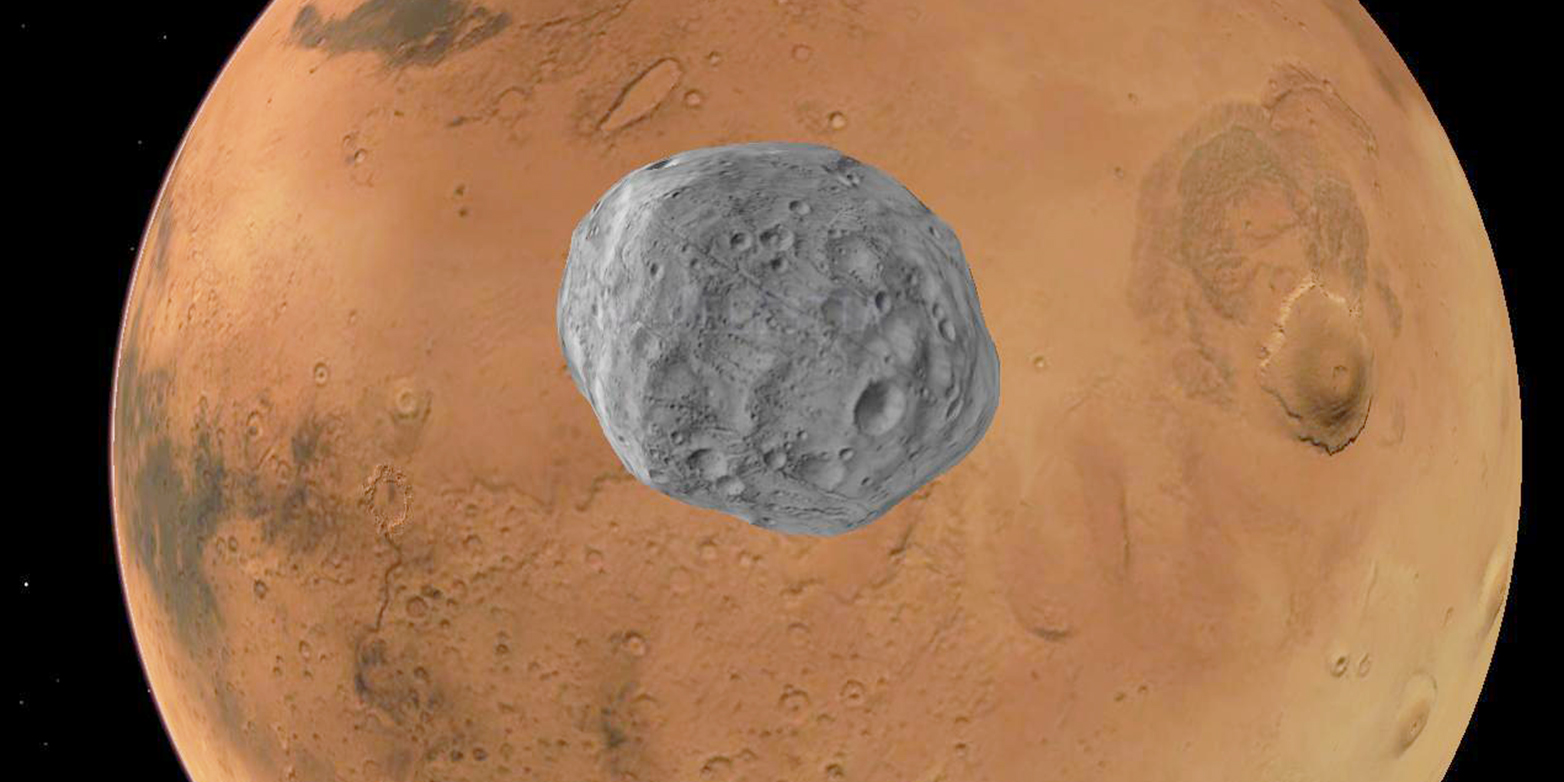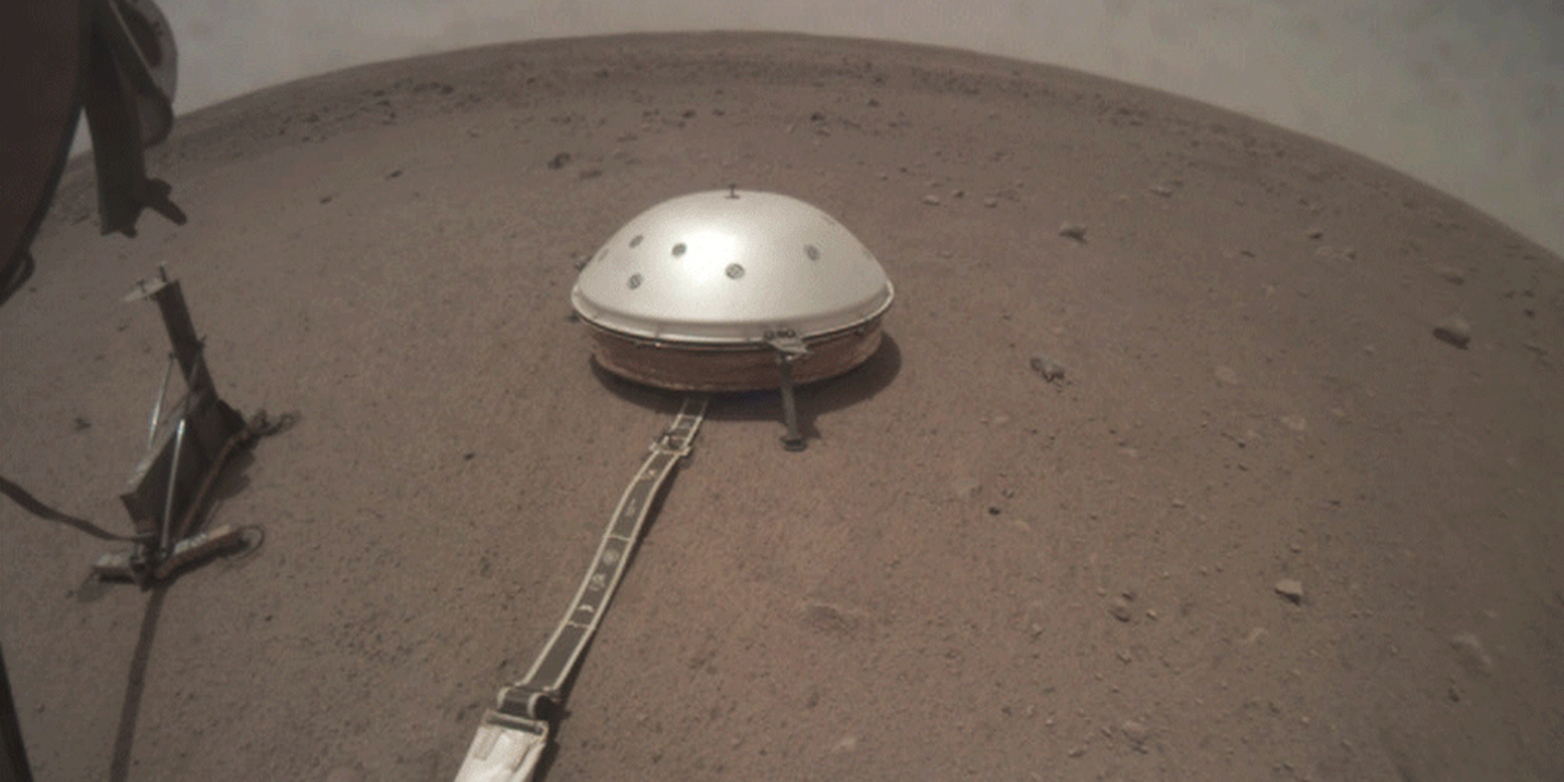Surprise on Mars
NASA’s InSight mission provides data from the surface of Mars. Its seismometer, equipped with electronics built at ETH Zurich, not only records marsquakes, but unexpectedly reacts to solar eclipses as well. When the Martian moon, Phobos moves directly in front of the sun, the instrument tips slightly to one side. This miniscule effect could aid researchers in determining the planet’s interior.

An observer standing on Mars would see the planet’s moon Phobos cross the sky from west to east every five hours. Its orbit passes between the sun and any given point on Mars about once each Earth year. Each time it does so, it causes from one to seven solar eclipses within the space of three days. One place where this happens is the site of NASA’s InSight lander, stationed in the Elysium Planitia region since November 2018. In other words, the phenomenon occurs much more frequently than on Earth, when our moon crosses in front of the sun. “However, the eclipses on Mars are shorter – they last just 30 seconds and are never total eclipses,” explains Simon Stähler, a seismologist at ETH Zurich’s Institute of Geophysics. Photos taken by NASA’s two Mars rovers, Opportunity and Curiosity, also show a sharp-edged lump against the backdrop of the sun.
Photographs are not the only way to observe these transits. “When Earth experiences a solar eclipse, instruments can detect a decline in temperature and rapid gusts of wind, as the atmosphere cools in one particular place and air rushes away from that spot,” Stähler explains. An analysis of the data from InSight should indicate whether similar effects are also detectable on Mars.
Waiting for 24 April 2020
In April 2019, the first series of solar eclipses were visible from InSight’s landing site, but only some of the data it recorded was saved. Initial indications from that data prompted Stähler and an international research team to prepare excitedly for the next series of eclipses, due on 24 April 2020. They published the findings from their observations in August in the journal Geophysical Research Letters.
As expected, InSight’s solar cells registered the transits. “When Phobos is in front of the sun, less sunlight reaches the solar cells, and these in turn produce less electricity,” Stähler explains. “The decline in light exposure caused by Phobos’s shadow can be measured.” Indeed, the amount of sunlight dipped during an eclipse by 30 percent. However, InSight’s weather instruments indicated no atmospheric changes, and the winds did not change as expected. Other instruments; however, delivered a surprise: both the seismometer and the magnetometer registered an effect.
Unusual signal from the seismometer
The signal from the magnetometer is most likely due to the decline in the solar cells’ electricity, as Anna Mittelholz, a recent addition to ETH Zurich’s Mars team, was able to show. “But we didn’t expect this seismometer reading; it’s an unusual signal,” Stähler says. Normally, the instrument – equipped with electronics built at ETH – would indicate quakes on the planet. So far the Marsquake Service, led by John Clinton and Domenico Giardini at ETH, has recorded about 40 conventional quakes, the strongest of which registered a magnitude of 3.8, as well as several hundred regional, shallow quakes.
What was surprising during the solar eclipse was that the seismometer tilted slightly in a particular direction. “This tilt is incredibly small,” Stähler notes. “Imagine a 5-franc coin; now, push two silver atoms under one edge. That’s the incline we’re talking about: 10-8.” As slight as this effect was, it was still unmistakable. “The most obvious explanation would be Phobos’s gravity, similar to how Earth’s moon causes the tides,” Stähler says, “but we quickly ruled this out.” If that were the explanation, then the seismometer signal would be present for a longer period of time and every five hours when Phobos makes its pass, not only during eclipses. Researchers determined the most likely cause of the tilt: “During an eclipse, the ground cools. It deforms unevenly, which tilts the instrument,” says Martin van Driel from the Seismology and Wave Physics research group.

As it happens, an infrared sensor did indeed measure a cooling of the ground on Mars of two degrees. Calculations revealed that in the 30 seconds of the eclipse, the “cold front” could penetrate the ground only to a depth of micro- or millimetres, but the effect was enough to tug at the seismometer.
Experiments in an old silver mine
An observation back on Earth supports Stähler’s theory. At the Black Forest Observatory, located in an abandoned silver mine in Germany, Rudolf Widmer-Schnidrig discovered a similar phenomenon: during a seismometer test, someone neglected to turn out the light. The heat given off by a 60-watt bulb was apparently enough to warm the topmost layer of granite deep below ground, so that it expanded slightly and caused the seismometer to tilt slightly to one side.
Scientists should be able to use the tiny tilt signal from Mars to map Phobos’ orbit with more precision than was previously possible. InSight’s position is the most accurately measured location on Mars; if the scientists know exactly when a transit by Phobos here begins and ends, they can calculate its orbit precisely. This is important for future space missions. For example, Japan’s space agency JAXA plans to send a probe to the moons of Mars in 2024 and bring samples from Phobos back to Earth. “To do that, they need to know exactly where they’re flying to,” says Stähler.
What precise orbit data reveals
Precise data on Phobos’s orbit could also shed more light on the inner workings of Mars. While our moon continues to gain angular momentum and is steadily moving away from Earth, Phobos is slowing down and gradually falling back to Mars. In 30 to 50 million years, it will crash onto the planet’s surface. “We can use this slight slowdown to estimate how elastic and thus how hot the Martian interior is; cold material is always more elastic than hot,” explains Amir Khan, also at ETH Zurich’s Institute of Geophysics. Ultimately, the researchers want to know if Mars was formed of the same material as Earth, or if different components could explain why Earth has plate tectonics, a dense atmosphere and conditions that support life – characteristics that Mars is lacking.
Reference
S.C. Stähler et al.: Geophysical observations of Phobos transits by In Sight, 04 August 2020, Geophysical Research Letters.
Doi: external page 10.1029/2020GL089099
Bagheri, A., Khan, A., Al-Attar, D., Crawford, O. & Giardini, D. Tidal Response of Mars Constrained From Laboratory-Based Viscoelastic Dissipation Models and Geophysical Data. J. Geophys. Res. Planets 124, 2703–2727 (2019). Doi: external page 10.1029/2019JE006015.
Comments
No comments yet